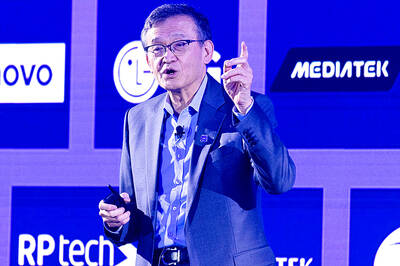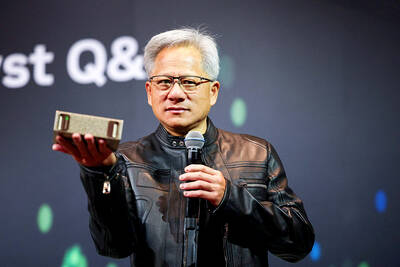Bank of Japan (BOJ) policymakers are prepared to consider expanding an emergency-loan program for banks and increasing purchases of government debt should the recovery falter, people with knowledge of the matter said.
The central bank’s board will leave interest rates and its lending program unchanged today, 16 of 17 economists said in a Bloomberg News survey. How it responds in coming months will depend on the extent of any further economic shocks — such as a surge in the yen to November’s 14-year high — the people said on condition of anonymity because the talks are private.
“Should a rise in the yen threaten to damp corporate and consumer sentiment and exacerbate deflation, the BOJ will probably expand the loan program,” said Masaaki Kanno, a 25-year veteran of the bank who is now chief economist at JPMorgan Chase & Co in Tokyo. “If that’s not enough, the bank may turn to more bond buying.”
While increased liquidity injections may help restrain the yen, an expansion of the monthly ¥1.8 trillion (US$20 billion) of bond purchases may spark concern that the BOJ is financing the government’s deficit spending. Central bankers would have to counter any such perception and may need to stress the urgency for Japanese Prime Minister Yukio Hatoyama’s administration to rein in the budget gap, one of the people said.
The BOJ may be unique in considering additional monetary stimulus among the G20 major economies this year. Exporters have led the rebound from the country’s worst postwar recession as falling wages, job losses and factory overcapacity hamper spending and deepen price declines.
BOJ Governor Masaaki Shirakawa and his colleagues, who began a two-day meeting yesterday, will leave the benchmark interest rate at 0.1 percent today, all of the 17 economists said in the survey.
One of the analysts, Hiromichi Shirakawa, chief economist at Credit Suisse Group AG in Tokyo, said the bank may expand the ¥10 trillion lending program it introduced on Dec. 1 in reaction to the yen’s climb to ¥84.83 per US dollar. The currency jumped more than 1 percent at the end of last week, to as high as ¥89.79 in Tokyo trading, underscoring the risk to the exporters.
The emergency lending facility, which provides commercial banks with funds for three months at 0.1 percent, could be expanded in stages, one of the people said. Along with increasing the size, officials might extend the maturity of the loans to six months and later to 12 months, the person said.
“The government may put the heat on the BOJ should the yen gain rapidly and stocks slide before the fiscal year-end,” said Mari Iwashita, chief market economist at Nikko Cordial Securities in Tokyo. “The government is overwhelmed by the task of passing next year’s budget bill, so it has no choice but to depend on the BOJ if the economy stumbles.”
So far, borrowing costs remain contained even as the fiscal condition deteriorates, as deflation attracts investors to government debt. The yield on the 10-year note was at 1.325 percent on Friday.
“I see a 30 percent chance that the bank will buy more bonds,” said Yasunari Ueno, chief economist at Mizuho Securities Co in Tokyo.

Intel Corp yesterday reinforced its determination to strengthen its partnerships with Taiwan’s ecosystem partners including original-electronic-manufacturing (OEM) companies such as Hon Hai Precision Industry Co (鴻海精密) and chipmaker United Microelectronics Corp (UMC, 聯電). “Tonight marks a new beginning. We renew our new partnership with Taiwan ecosystem,” Intel new chief executive officer Tan Lip-bu (陳立武) said at a dinner with representatives from the company’s local partners, celebrating the 40th anniversary of the US chip giant’s presence in Taiwan. Tan took the reins at Intel six weeks ago aiming to reform the chipmaker and revive its past glory. This is the first time Tan

Qualcomm Inc is strengthening its partnerships with Taiwan Semiconductor Manufacturing Co (TSMC, 台積電) and original design manufacturers (ODMs) in Taiwan as it expands its presence in the artificial intelligence (AI) computer market, CEO Cristiano Amon said in Taipei yesterday ahead of the annual Computex trade show. “Historically we’ve always been a very big customer of TSMC, and we continue to be,” Amon said during a media Q&A session. “For chip manufacturing, we’re among the largest fabless [semiconductor designers],” he said, noting that Qualcomm, a leading provider of mobile and AI-enabled chipsets, ships about 40 billion components every year, with TSMC being

‘FAILED EXPORT CONTROLS’: Jensen Huang said that Washington should maximize the speed of AI diffusion, because not doing so would give competitors an advantage Nvidia Corp cofounder and chief executive officer Jensen Huang (黃仁勳) yesterday criticized the US government’s restrictions on exports of artificial intelligence (AI) chips to China, saying that the policy was a failure and would only spur China to accelerate AI development. The export controls gave China the spirit, motivation and government support to accelerate AI development, Huang told reporters at the Computex trade show in Taipei. The competition in China is already intense, given its strong software capabilities, extensive technology ecosystems and work efficiency, he said. “All in all, the export controls were a failure. The facts would suggest it,” he said. “The US

NEW PRODUCTS: MediaTek has been diversifying its product lines to minimize operational risks as mobile chips remain the company’s biggest revenue source MediaTek Inc (聯發科), the world’s biggest supplier of smartphone chips, yesterday said the tape-out process for its first 2-nanometer chip would take place in September, paving the way for volume production of its most advanced chip, likely to be its next-generation flagship smartphone chip, around the year-end at the earliest. MediaTek has been leveraging advanced process technologies from its foundry partner, Taiwan Semiconductor Manufacturing Co (TSMC, 台積電), to build its flagship mobile phone chips, a segment it once relinquished and then recovered four years ago as it released its Dimensity series. In the semiconductor industry, a tape-out refers to the